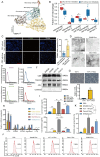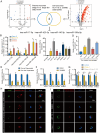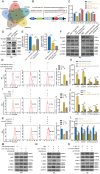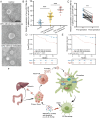Exosomal miR-106a-5p from highly metastatic colorectal cancer cells drives liver metastasis by inducing macrophage M2 polarization in the tumor microenvironment
- PMID: 39385295
- PMCID: PMC11462797
- DOI: 10.1186/s13046-024-03204-7
Exosomal miR-106a-5p from highly metastatic colorectal cancer cells drives liver metastasis by inducing macrophage M2 polarization in the tumor microenvironment
Abstract
Background: The tumor microenvironment (TME) is a dynamic system orchestrated by intricate cell-to-cell crosstalk. Specifically, macrophages within the TME play a crucial role in driving tumor progression. Exosomes are key mediators of communication between tumor cells and the TME. However, the mechanisms underlying exosome-driven crosstalk between tumor cells and macrophages during colorectal cancer (CRC) progression remain incompletely elucidated.
Methods: Single-cell RNA sequencing were analyzed using the Seurat package. Exosomes were isolated using ultracentrifugation and characterized by transmission electron microscopy, nanoparticle tracking analysis, and western blot. miRNAs differentially expressed in exosomes were analyzed using the limma package. CD206 expression in CRC tissues, exosomes tracing, and exosomal miR-106a-5p transport were observed through immunofluorescence. Macrophage polarization was assessed via qRT-PCR, ELISA, and flow cytometry. The interactions between miR-106a-5p, hnRNPA1, and SOCS6 were evaluated using miRNA pull-down, RIP, and dual-luciferase reporter assays. Transwell assays and liver metastasis model explored the role of exosomal miR-106a-5p-induced M2 macrophages in promoting CRC liver metastasis.
Result: The proportion of M2 macrophages is increased in CRC with liver metastasis compared to those without. Highly metastatic CRC cells release exosomes enriched with miR-106a-5p, which promote macrophages M2 polarization by suppressing SOCS6 and activating JAK2/STAT3 pathway. These M2 macrophages reciprocally enhance CRC liver metastasis. hnRNPA1 regulate the transport of miR-106a-5p into exosomes. Clinically, elevated miR-106a-5p in plasma exosomes correlated with liver metastasis and poor prognosis.
Conclusion: CRC-derived exosomal miR-106a-5p plays a critical role in promoting liver metastasis and is a potential biomarker for the prevention and treatment of CRC liver metastasis.
Keywords: Colorectal cancer; Exosomes; Liver metastasis; Macrophage; miRNAs.
© 2024. The Author(s).
Conflict of interest statement
The authors declare that they have no conflict of interest.
Figures







Similar articles
-
Tumor-derived exosomal miR-934 induces macrophage M2 polarization to promote liver metastasis of colorectal cancer.J Hematol Oncol. 2020 Nov 19;13(1):156. doi: 10.1186/s13045-020-00991-2. J Hematol Oncol. 2020. PMID: 33213490 Free PMC article.
-
Colorectal cancer cells-derived exosomal miR-188-3p promotes liver metastasis by creating a pre-metastatic niche via activation of hepatic stellate cells.J Transl Med. 2025 Mar 25;23(1):369. doi: 10.1186/s12967-025-06334-4. J Transl Med. 2025. PMID: 40134019 Free PMC article.
-
Colorectal cancer tumor cell-derived exosomal miR-203a-3p promotes CRC metastasis by targeting PTEN-induced macrophage polarization.Gene. 2023 Nov 15;885:147692. doi: 10.1016/j.gene.2023.147692. Epub 2023 Aug 9. Gene. 2023. PMID: 37562585
-
The effect of cancer cell-derived exosomal proteins on macrophage polarization: An in-depth review.Exp Cell Res. 2025 Jan 15;444(2):114393. doi: 10.1016/j.yexcr.2024.114393. Epub 2024 Dec 20. Exp Cell Res. 2025. PMID: 39710293 Review.
-
Role of cancer cell-derived exosomal glycoproteins in macrophage polarization.Mol Biol Rep. 2025 May 10;52(1):451. doi: 10.1007/s11033-025-10535-x. Mol Biol Rep. 2025. PMID: 40347313 Review.
Cited by
-
Research progress of colorectal cancer in genomic and transcriptomic at multi-level.Front Genet. 2025 May 30;16:1533817. doi: 10.3389/fgene.2025.1533817. eCollection 2025. Front Genet. 2025. PMID: 40520235 Free PMC article. Review.
-
Identification and evaluation of metabolic mRNAs and key miRNAs in colorectal cancer liver metastasis.Cancer Cell Int. 2025 Jul 16;25(1):265. doi: 10.1186/s12935-025-03903-x. Cancer Cell Int. 2025. PMID: 40671011 Free PMC article.
-
Associations of blood RNA biomarkers and circulating tumour cells in patients with previously untreated metastatic colorectal cancer.BMC Cancer. 2025 Apr 21;25(1):743. doi: 10.1186/s12885-025-14098-9. BMC Cancer. 2025. PMID: 40259317 Free PMC article.
-
The LncRNA STEAP3-AS1 promotes liver metastasis in colorectal cancer by regulating histone lactylation through chromatin remodelling.J Exp Clin Cancer Res. 2025 Jul 15;44(1):205. doi: 10.1186/s13046-025-03461-0. J Exp Clin Cancer Res. 2025. PMID: 40665344 Free PMC article.
-
Research hotspots and frontiers in the tumor microenvironment of colorectal cancer: a bibliometric study from 2014 to 2024.Front Oncol. 2025 Feb 5;15:1525280. doi: 10.3389/fonc.2025.1525280. eCollection 2025. Front Oncol. 2025. PMID: 39975599 Free PMC article.
References
-
- Sung H, Ferlay J, Siegel RL, Laversanne M, Soerjomataram I, Jemal A, et al. Global Cancer statistics 2020: GLOBOCAN estimates of incidence and Mortality Worldwide for 36 cancers in 185 countries. CA Cancer J Clin. 2021;71:209–49. - PubMed
-
- Siegel RL, Wagle NS, Cercek A, Smith RA, Jemal A. Colorectal cancer statistics, 2023. CA Cancer J Clin. 2023;73:233–54. - PubMed
-
- Margonis GA, Sergentanis TN, Ntanasis-Stathopoulos I, Andreatos N, Tzanninis IG, Sasaki K, et al. Impact of Surgical Margin Width on recurrence and overall survival following R0 hepatic resection of colorectal metastases: a systematic review and Meta-analysis. Ann Surg. 2018;267:1047–55. - PubMed
-
- Yang L, Li T, Shi H, Zhou Z, Huang Z, Lei X. The cellular and molecular components involved in pre-metastatic niche formation in colorectal cancer liver metastasis. Expert Rev Gastroenterol Hepatol. 2021;15:389–99. - PubMed
MeSH terms
Substances
Grants and funding
LinkOut - more resources
Full Text Sources
Medical
Miscellaneous

